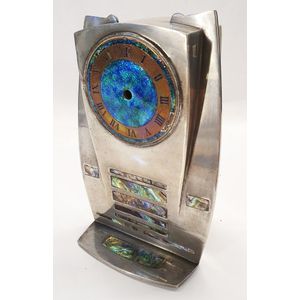The world renowned department store Liberty, was originally founded in 1875 as a furniture and drapery shop in Regent Street, London and was known as "East India House".
The business was established by Arthur Lazenby Liberty, (1843-1917). As the original name of the shop suggests, there was a strong emphasis on Oriental & Moorish objects, furniture and fabrics as well as more traditional European items. Under the heading of "curios", he also sold Japanese bric-a-brac of all kinds.
East India House was one of the first major shops to stock extensively products of the Arts and Crafts movement.
more...
Goods subsequently produced for Liberty showed both Oriental and Arts and Crafts influence.
In 1884 Liberty opened a costume department and in 1885 a wallpaper department.
Liberty commissioned leading designers of the time to create carpets, ceramics, clothing, furniture, silver and wallpaper exclusively for them.
In 1889 Liberty opened a branch in Paris which was instrumental in exposing Europeans to English Art Nouveau style.
Liberty registered their own silver hallmark in 1894 and in 1899 released a range of gold and silver objects under the name "Cymric", an Art Nouveau interpretation of the Celtic style. They were made by the Birmingham-based company W. H. Haseler.
In 1903 a range of pewter of similar design was released under the name "Tudric". Apart from its interesting designs, Tudric pewter differed from other pewter as it had a high silver content. It was also produced for Liberty by William Haseler of Birmingham.
From 1898 onwards, Liberty retained the services of Archibald Knox (1864-1933). Knox designed much of the Tudric Pewter and Cymric silver as well as textiles, and has been credited with 400 designs.
House rules prevented Liberty designers being allowed to sign their works, except for Archibald Knox.
Pieces with a Knox attribution tend to be the most sought after by collectors, and command a premium in price. Particularly desirable are those items with strong Celtic motifs and brightly coloured enamelling.
Liberty still trades from Regent Street, London.
less...
Pewter is an alloy of tin hardened with small amounts of other metals such as copper, lead, zinc, antimony and sometimes silver. The craft of pewtering started in antiquity - the earliest known item, a flask dating from c1450 BC, was found in Egypt.
Pewter is believed to have been introduced to Britain by the Romans, who exploited the main source of tin in Europe at the time, which was in Cornwall. The craft fell into decline after the Romans withdrew from Britain but it is thought that the Cistercian monks reintroduced it after the Norman Conquest in AD 1066.
Known
more...
as "the poor man's silver", production spread throughout the country with a wide range of mainly domestic goods being made.
In the year 1348 Articles were granted to the Worshipful Company of Pewterers in London, which enabled them to control the quality of pewter. Two grades of pewter were specified, and then later a further grade was added, and these three grades were adhered to until the 20th century.
The 15th and 16th centuries are described as the Golden Age for pewter manufacture, a time when even grand houses used pewter as well as silver for domestic use and a time which preceded the introduction of mass-produced ceramic wares, which ultimately replaced pewter, especially plates and drinking vessels.
Even then however, the average householder was too poor to replace his wooden utensils with pewter until around the middle of the 18th century. For almost a hundred years thereafter it became the material for every day utensils and commodities.
The appeal of pewter comes mainly from its good proportions and functional design. Items from the 17th and 18th centuries are obviously much rarer than those of the 19th century, which form the basis of most collections, and when collecting pewter became popular. The century culminated in the formation of The Society of Pewter Collectors in 1918, which is still operating today, under the name of the Pewter Society.
Although ceramic tableware had largely replaced pewter by this time, tankards, mugs, beakers, candlesticks, measures and numerous small personal items were still being made, and were popular in the country. . In churches it was used to make alms dishes, plates and sacramental vessels.
In the early 20th century, the popularity of pewter was revived with the introduction of the Art Nouveau styles of Liberty's Tudric range.
There are no hallmarks on pewter, although some pewter items have a touch mark, applied by a punch and which usually include the names or initials of the maker. Touch marks have no particular value apart from interest and a guide to the maker. A touch mark bears no relation to the quality of the alloy, and does not carry the same authority as the hallmarks used on gold and silver.
When a date appears as part of the touch mark it represents the year of registration of the maker with the London Guild and not the year of manufacture, so it can't be used to date the article. However, if the manufacturer is known the piece can be dated to a certain period, somewhere between the date of registration and death of the maker.
Sometimes the makers added touch marks resembling silver hallmarks, usually four in number. These faux hall marks were not recognised by The Worshipful Company of Pewterers or supported in law.
less...







